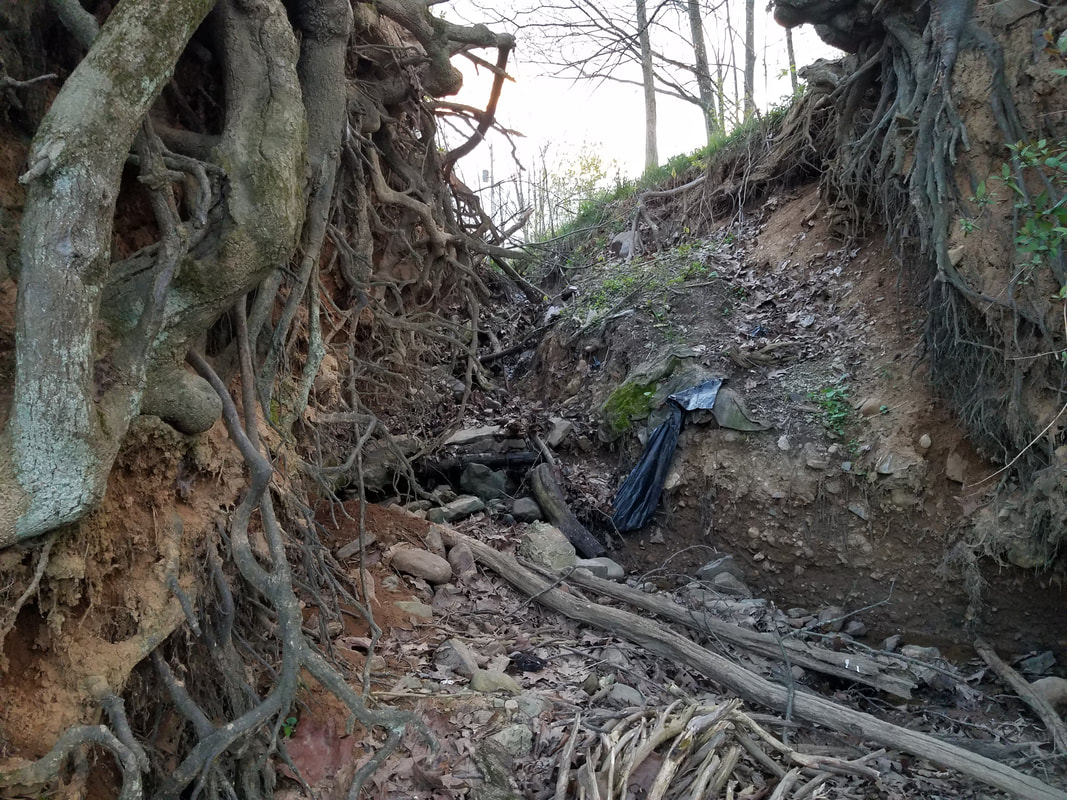|
Intermingling sets of roots weave their way through the soil and ultimately preserve stream banks that receive a constant barrage of wear and tear from running water and various debris that floats down the waterways. But what happens when the vegetation that produces the various root systems is removed? One of the biggest pollutants in our greater watershed is, surprising, sedimentation. It is the growing amounts of soil that wash away from banks and ultimately wind up in waterways, making them much more shallow and even re-routing their paths.
The changes connected with the increasing amount of sedimentation goes beyond the physical channel of the streams, creeks and rivers in our backyards – but also directly impacts microorganisms, macroinvertebrates, aquatic plants and the entire aquatic ecosystem. The dangerous ripple effect doesn’t happen over night – it changes ever so slowly. Yet over time, the impacts can be devastating. There is a small stream that feeds into the Penns Creek that is a great example of the damage that can be done by erosion fueled by loss of vegetation and increased flooding issues. One of the biggest stewards of erosion control and streambank management is the network of county conservation districts throughout the state. They handle contracts and permits that directly impact stability of our creeks and rivers. They work with residents to develop sedimentation plans, and help farmers determine the best ways to use their land while not adding to the growing pollutants in our waterways. In a way, the network of country conservation districts provide the symbolic root structure that protects our streams, creeks and rivers. Which makes legislation such as House Bill 1822 such a concern. The bill, which passed the state House on April 21, includes language that would freeze any new contracts – or funding for contracts – to all county conservation districts. It also would impact the state’s Growing Greener fund, among other environmentally focused programs. “It basically means that any funding that we don’t currently have a contract for will be frozen, and with our budget year ending on June 30, this is concerning,” said Northumberland County Conservation District Executive Director Judy Becker. “We have not received a funding increase as an agency since the 2004-2004 state budget, and like everything else, what we do has increasing costs. We aren’t asking for an increase now – to do so considering the economic downtown of COVID-19 would be irresponsible. However, adding a potential freeze on funding for new contracts could add quite a big blow to a process that is already maxed out.” Ultimately, if certain lines of funding are frozen, Becker added, it may mean they’ll have inadequate resources to perform inspections at construction sites, which play a role in reviewing permits and approving them in a timely manner as construction companies look to resume operations and hopefully revitalize a stagnant economy. “We are a small staff – very small. We have six full-time employees doing all these programs and who are responsible for all of Northumberland County,” she said. “It is a pretty significant role we carry on our shoulders, and if I lose staff people, there would definitely be implications on environmental issues.” It is important to note that HB 1822 wasn’t developed to focus on funding cuts to agencies such as the conservation districts. “The bill deals with helping rural and small businesses in the state. An appropriations committee later added, as an amendment, that these districts shouldn’t be taking on new contracts when we don’t know if the funding will be there to pay for them,” said Representative Mark Keller, serving Perry County and part of Cumberland County – who introduced the original HB 1822. “This wasn’t something I personally did or was in favor of. It happens as part of the legislative process.” That doesn’t mean he is against the addition. “I live on a farm. Say I have a contract with the conservation district on how to plow my field so the drainage is right – that does not need to be done right now,” he said. “The districts’ quarterly payments will still come to them – it isn’t defunding conservation districts, just asking them to be a little more careful and not taking on new contracts. We are $4 billion in the hole already. It basically suggests not signing anything new due to dollar amounts that may not be there.” While HB 1822 passed the state House, there is no known timeline for it to be considered by the Senate – and even when/if it is, the bill may be modified from its current format. Yet, HB 1822 is just one piece of potential legislation that has a potential environmental impact. Others include HB 2416 and HB 2004, focusing on different funds, programs and processes. Ultimately, we all are heading into a very tenuous situation – the convergence of the coronavirus pandemic and its ripple effect among businesses, state agencies, nonprofits and environmental initiatives with the impending deadline of the state budget. As this process comes to a boiling point, it is more important than ever to be educated on the bills that are going through the legislative circles and making sure that they don’t pick apart any critical environmental programs or initiatives that could cause devastating long-term and difficult-to-reverse impacts on our ecosystem. Otherwise, we may be left with nothing more than a collective washed out streambank of important programs and missed opportunities that would leave behind a ripple effect that impacts all levels of our aquatic ecosystem.
1 Comment
Leave a Reply. |
AuthorsRiverkeeper John Zaktansky is an award-winning journalist and avid promoter of the outdoors who loves camping, kayaking, fishing and hunting with the family. Archives
July 2024
Topics |

 RSS Feed
RSS Feed